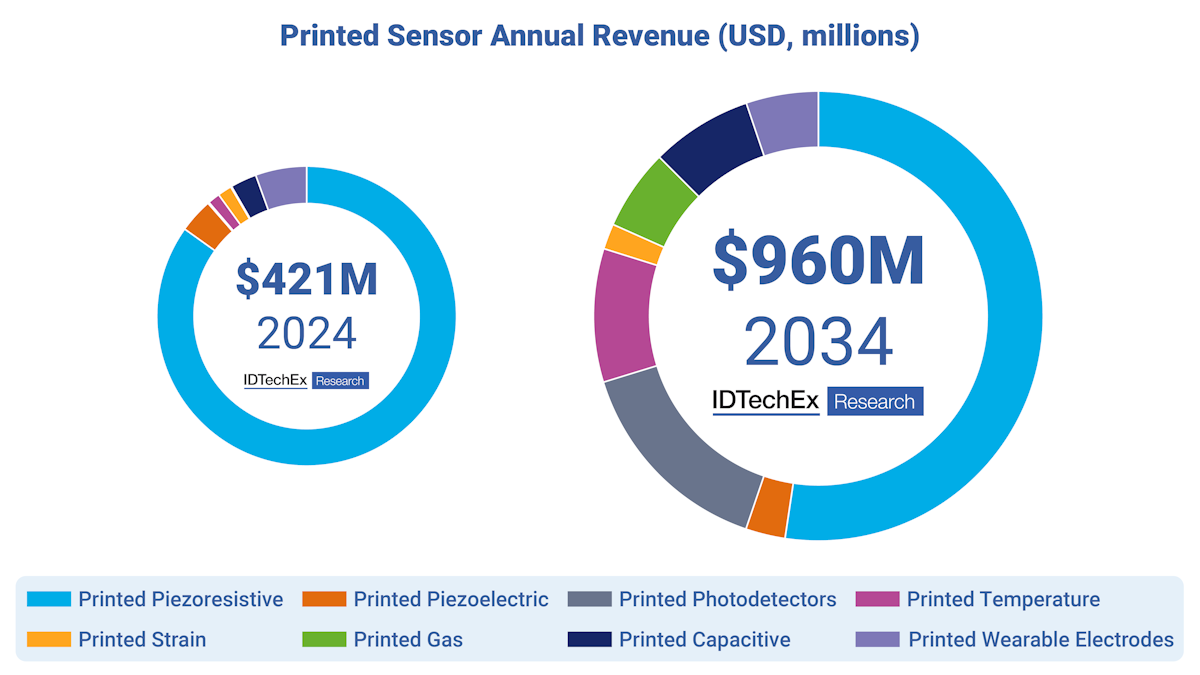Printed and Flexible Sensors 2024-2034: Technologies, Players, Marketsプリンテッド・フレキシブルセンサー 2024-2034:技術、プレーヤー、市場 この調査レポートでは、プリンテッドセンサーとフレキシブルセンサーの市場、技術、プレーヤーについて詳細に調査・分析しています。 主な掲載内容(目次より抜粋) 市場予測 ... もっと見る
※ 調査会社の事情により、予告なしに価格が変更になる場合がございます。
Summary
この調査レポートでは、プリンテッドセンサーとフレキシブルセンサーの市場、技術、プレーヤーについて詳細に調査・分析しています。
主な掲載内容(目次より抜粋)
Report Summary
This report characterizes the markets, technologies, and players in printed and flexible sensors. The latest technical innovations are explored across eight printed sensor technology areas, with numerous application case studies for each technology. It reveals significant opportunity, with the printed and flexible sensor market forecast to grow to over US$960M by 2034.
Sensors, of which a subset are printed and flexible, are vital in modern life. They measure a vast quantity of physical parameters, acting as the interface between the physical and digital worlds. Printed sensors are relatively self-explanatory - they are sensors that are printed using solution processable functional inks onto rigid or flexible substrates. Printed sensors can therefore be produced in large areas and volumes, using established manufacturing techniques at significantly reduced costs.
Printed and flexible sensors can measure a plethora of physical interactions, including touch, force, pressure, displacement, temperature, electrical signals, as well as detecting gases. One of the earliest, and now most ubiquitous, printed sensor technologies is printed force sensors, which are found in cars for seat belt occupancy detection. Printed sensors find applications in commercial sectors such as automotives, healthcare, wearables, consumer electronics, industry, and logistics.
While force sensor markets are established and dominate revenue share, other printed and flexible sensor technologies are poised for growth over the next decade. Printed sensors are emerging in consumer electronic devices, from laptops to power tools, and are projected to continue growing. Also, the offering of large area, lightweight sensing makes printed and flexible sensors well-suited for integration in automotives. Emerging automotive applications include battery health monitoring and human machine interfaces, employing printed sensors for pressure, force, gas, and temperature sensing. Specifically, multifunctional printed sensors are evolving quickly to meet market demands, with disruptive potential within existing sensors industries, in addition to unlocking wholly new and novel sensing solutions.
Printed sensor annual revenue, segmented by technology, 2024-2034. Source IDTechEx
This report critically evaluates eight printed sensor technologies, covering printed piezoresistive sensors and force sensors (FSRs), piezoelectric sensors, photodetectors, temperature sensors, strain sensors, gas sensors, capacitive touch sensors, and wearable electrodes. The report also discusses areas of innovation in manufacturing of printed sensors, including focus on emerging material options as well as the technology underlying the manufacturing process. This report characterizes each application of printed sensors, discussing the relevant technology, product types, competitive landscape, industry players, pricing, as well as key meta-trends and drivers for each sector. The report also contains detailed printed and flexible sensors market forecasting over 10 years for each of the key printed sensor technology areas.
The research behind the report has been compiled over many years by IDTechEx analysts. It builds on existing expertise in areas such as sensors, wearable technology, flexible electronics, stretchable and conformal electronics, smart packaging, conductive inks, nanotechnology, future mobility and electronic textiles. The methodology involved a mixture of primary and secondary research, with a key focus on speaking to executives, engineers, and scientists from companies developing printed and flexible sensors. As such, the report analyses all known major companies and projects, including over 35 profiles.
Unique position and experience behind the report
IDTechEx is afforded a particularly unique position in covering this topic. The analyst team builds on decades of experience covering emerging technology markets, and particularly areas, such as printed electronics, which are central to printed and flexible sensors. This has been historically supported by IDTechEx's parallel activities in organizing the leading industry conferences and exhibitions covering printed, flexible, and wearable electronics. IDTechEx has the unique ability to curate a network in these topic areas, facilitating the analysis in this report.
This report provides critical market intelligence about the eight printed sensor technology areas involved. This includes:
Full market characterization for each printed sensor technology:
Market analysis throughout:
Key aspects
This report provides the following information:
Technology trends & manufacturer analysis
Market Forecasts & Analysis:
Table of Contents
|





